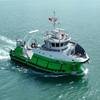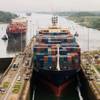Historic Side-wheeler Christened
Constructed in Eagle City, Alaska, by Nick Turner and Charlie House, the vessel offers three passenger decks, a food service galley and two staterooms for crews. Eagle City is located along the Yukon River approximately 9 miles west of the Canadian border.
The KLONDIKE SPIRIT is the first side-wheeler to be built on the Yukon in decades. Historically, side-wheelers were used to navigate rivers because their configuration made them extremely maneuverable. However, the location of the paddles along both sides of the boats made them vulnerable to damage, and their popularity faded. The KLONDIKE SPIRIT brings back a piece of nostalgia that complements Dawson's "Gold Rush" tourist theme.
According to Turner; "The recommendations made by Elliott Bay Design Group enabled for U.S. Coast Guard plan approval, while preserving each detail of our design concept."
The side-wheeler is 88 ft long with 18 ft beam and a 4 ft hull depth. Maximum draft is 30 inches. The hull was fabricated by Eagle Boat Company and the Northern Lights 20 kW generator was furnished by Alaska Diesel Electric. The main engine is a 400 HP Cat 3406 that drives Denison hydraulic pumps. Hydraulic motors power each side wheel through a separate Brevini gearbox and 3:1 chain reduction drive. Paddle wheel speed is 40 RPM.
Elliott Bay Design Group's contributions included structural calculations and scantling determinations for U.S. Coast Guard approval. The firm also performed tonnage analysis, designed the tonnage plan, and performed the admeasurement survey on behalf of Germanischer Lloyd.
Currents in the Yukon River and the absence of a dock made performing stability tests a challenge. Typically, such tests are executed in protected water with the vessel tethered to a dock with no outside forces affecting the boat. Because that wasn't an option, Elliott Bay Design Group engineers tied the KLONDIKE SPIRIT to trees on the river's shore, and then floated the boat onto an eddy.
Currents flowing down one side of the boat at four knots and up the other side at two knots kept the side-wheeler steady and the mooring lines slack for the duration of the test.
EBDG performed the tests and inspection in early October 2004, just before the river froze for the winter.










